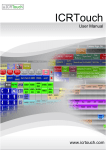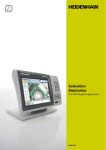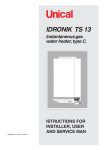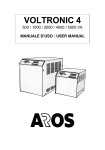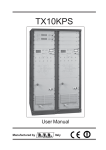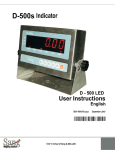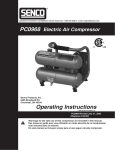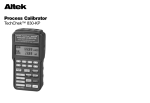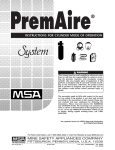Download ESP Sting User`s guide
Transcript
Users_guide_cover.fh8 8/13/04 12:48 PM Page 2 C Composite M Y CM MY CY CMY K TM Miniature Digital Recorder Table of Contents i Table of Contents INTRODUCTION................................................ 4 Box Contents ...................................................... 5 TECHNICAL SPECS ............................................ 6 STING COMPONENTS ........................................ 8 Top View ............................................................ 8 Left- and Right-Side View ..................................... 9 Accessories......................................................... 9 GETTING STARTED.......................................... 10 1. First-Time Charging ....................................... 11 2. Installing STING Media Center......................... 12 3. Setting Current Time...................................... 14 4. Formatting Microdrive .................................... 15 5. Connecting the A/V Cable ............................... 16 6. Connecting Camera / Microphone .................... 18 RECORDING WITH STING BUTTONS & LIGHTS....... 20 Recording Readiness Indication ........................... 21 Setting Recording Mode & Quality........................ 22 ii Table of Contents Starting and Stopping a Recording....................... 26 Memory Status Indication................................... 28 RECORDING WITH REMOTE CONTROL ............ 30 Starting and Stopping a Recording....................... 31 Low Battery & Low Memory Indication........................ 33 Alarm Indication................................................ 33 ALARM TRIGGER SWITCH ............................... 35 VIEWING AND MANAGING RECORDINGS........ 37 To Connect STING or Microdrive to PC........................ 37 Accessing STING Files Directly ............................ 39 Starting the STING Media Center......................... 40 MAINTENANCE AND TROUBLESHOOTING ....... 41 Caring for the STING ......................................... 41 Troubleshooting ................................................ 41 OPTIONAL ACCESSORIES ............................... 44 About this Document iii About this Document This user‘s guide explains how to install, connect, and use the STING, a portable digital recorder. It is intended for users of the device, and does not require special technical knowledge. The STING ships with a Windows software program, STING Media Center, used for playing and managing recordings. For more details on using this program, press Help in its main screen. 4 Introduction Introduction The STING™ (patent pending) is the smallest video/audio digital recorder in the world. It is a wearable recorder, able to record video and audio, or audio only, using MPEG-2 format. Recordings are stored on Microdrive or Compact Flash plug-in cards. The STING™ ships with a 4GB Microdrive. The STING is designed mainly for surveillance purposes by law-enforcement and government Introduction 5 organizations, for portable video/audio recording featuring the highest quality available. The STING accepts composite video input from any video camera. Box Contents A/V cable Vibrating remote control cable 6-foot USB cable 5-inch USB cable 4GB Microdrive PCMCIA adapter Multi-standard universal battery wall charger Car battery charger STING Media Center installation CD User‘s guide 6 Technical Specs Technical Specs Physical 78mm X 60mm X 32mm dimensions (3.07" X 2.36" X 1.26") Weight Recorder net: 98g (3.45 oz) Recorder w/drive: 114g (4 oz) Memory type Microdrive or Compact Flash plug-in cards. Storage Shipped with a 4GB Microdrive. capacity Accepts any Microdrive or Compact Flash card. Video storage Digital MPEG-2. format Recording time 2-8 hours video (depending on quality) or 75 hours audio. Video Approx. 15 minutes for 4GB, download time with USB 2.0 connection. Technical Specs 7 Memory erase 10 seconds. time Internal Lithium-iron. Provides approx. battery 3 hours of operation. External Accepts 90-240 VAC. charger Connectors for Europe, US, UK. Camera power 5V, 500mA output for a 5-V source camera (2 hours recording time). 1.3 mm connector. External power 7-12V (min. 800mA), 1.7 mm input connector (center +). Video input PAL / NTSC std. composite video. RCA / 3.5mm connector. Audio Input Line-level audio. RCA connector. PC interface USB 1.1 or USB 2.0 (USB 2.0 recommended). Video/audio MPEG-2 compatible players playback (e.g. Windows Media Player). 8 STING Components STING Components Top View STING Components 9 Left- and Right-Side View Accessories Battery Charger R/C with vibrating cable PCMCIA Adapter Micro- V/A USB drive Cable Cable 10 Getting Started Getting Started When you receive your STING, remove it from the packaging, check that you have all the accessories (see page 5), and then follow the instructions below. Each step is explained in more detail in a following section. To get your STING up and running: 1. C harge the unit. 2. I nstall STING Media Center. 3. S et the current time. 4. I nsert and format the memory card. 5. C onnect the A/V cable to the STING. 6. C onnect a camera or microphone to the A/V cable. Getting Started 11 1. First-Time Charging The STING ships with its battery uncharged. The first time you charge the unit, a 6-hour charging period is required. Afterwards, the unit charges fully in 4 hours. To charge the battery for the first time: 1. I nsert the charger plug into the unit, as shown in the image below. The green light comes on, indicating that the battery is being charged. 2. C harge the battery for 6 hours. 12 Getting Started 2. Installing STING Media Center STING Media Center is a software program that communicates with your STING, and allows you to preview, upload and delete recordings. The program also allows you to set the current time (see page 8). For more details on using STING Media Center, refer to the help file, accessed by pressing Help in the program‘s main screen. To install the STING Media Center: 1. Insert the STING™ mini-disk into the CD drive in your computer. The Visual Introduction screen appears. Getting Started 13 Note: The options at the bottom-left of the startup screen (Charging, Microdrive, etc.) show images and instructions on how to operate the STING. 2. Press the button labeled Install STING Media Center, located at the top-right of the screen. The installation wizard starts. 3. C lick Next, accept the license agreement and press Next again. 4. Press Install. A progress bar is shown. 5. When installation ends, press Finish. 14 Getting Started 3. Setting Current Time The memory chip in the STING contains a real-time clock, used to attach a timestamp to each recording. You must set the current time after receiving the unit, using the instructions below. The time is saved to persistent memory, so there is no need to set it again, unless you move to another time zone. To set the current time on the STING: 1. Turn on your PC and wait for Windows to start. 2. C onnect the USB cable (supplied) to the Sting device. 3. Turn on the STING using the On/Off Button (see page 8). 4. C onnect the other end of the USB cable to a vacant USB port on your PC. 5. Wait for the device to be recognized by Windows. Usually, this is indicated by a bell sound and a message box. Getting Started 15 6. S tart the Sting Media Center by clicking its desktop icon, or by clicking the Start button and selecting Programs > STING > STING Media Center. 7. Make sure your Windows clock is accurate. To change it, double-click the clock at the bottomright of the screen. 8. I n the Sting Media Center, in the Time Management area, press the Current Time button. The Windows clock time appears in the time/date box above the button. 9. Press Set Time to set the current time on the STING device. 10. Restart the STING. 4. Formatting Microdrive The STING ships with a 4GB Microdrive card. Before you can record, you must format the card, as explained below. If you switch to another card in the future, repeat this procedure to erase the new card. 16 Getting Started To format the Microdrive card: 1. I nsert the Microdrive card, with the printed side facing down, as shown in the image below. Push it in until it latches. 2. With the tip of a pen or pencil, gently press the ERASE Card until the green light, located on the right of the REC button, flashes for 10 seconds as the disk is erased. Wait for the light to turn off. 5. Connecting the A/V Cable The A/V cable has two RCA-type sockets on one end, and a 3.5mm plug on the other end, which connects to the STING. Getting Started 17 To connect the V/A cable to the STING: Plug the 3.5mm plug into the socket on the STING, as illustrated below. Make sure it is plugged all the way into the center hole. 18 Getting Started 6. Connecting Camera / Microphone You can connect any video camera to the STING. If the camera operates on 5VDC, it can draw its power from the Camera Power Out socket (see page 8, leftside view), as long as the current consumption does not exceed 500mA. If the camera does not comply with these requirements, it should be powered by its own battery. Alternatively, you can connect an amplified microphone, or any other device that sends out a line-level signal. An amplified button microphone is sold separately. The STING A/V cable has two RCA-type sockets: Video socket (yellow) - accepts composite video, PAL or NTSC from a video camera. Audio socket (red) - accepts line-level signal from an amplified microphone. Getting Started 19 To connect a camera or microphone: 1. Plug the RCA plug from your camera or microphone into the A/V cable: If you are plugging in a camera, and it has only one RCA connector, plug it into the yellow socket. If the camera has two connectors, plug the yellow one (video) into the yellow socket and the red one (audio) into the red socket. If you are plugging in a microphone, plug its RCA connector into the red socket of the A/V cable. Audio Video 2. If your camera operates on 5V, and its power consumption does not exceed 500mA, plug its power cable into the Camera Power Out socket (see page 8). 20 Recording With STING Buttons & Lights Recording With STING Buttons & Lights This chapter explains how to start and stop a recording, and receive status indications, using the buttons and lights on the STING device. To learn how to record and receive status indications with the STING's remote control, see page 30. Note: The STING's lights may show through thin fabrics. When wearing the STING under your clothing, it is advisable to have the lights facing the body, or to cover them with masking-tape. Recording With STING Buttons & Lights 21 Recording Readiness Indication When the STING turns on, there is a 25-second warm-up period. You cannot record until the warmup is finished. The light on the right of the REC button (shown below) indicates whether the device is ready to record or not. 22 Recording With STING Buttons & Lights The light may be either red or green (as shown on the previous page): Red indicates the STING is still warming up, and is not ready for recording. The light is also red if the device is currently recording (see page 26 to learn how to start and stop a recording). Green indicates the STING is ready for recording. Setting Recording Mode & Quality The light on the left of the REC button (shown on the following page), indicates two things: Recording mode - video and audio; audio only. Video quality - determines the total number of hours that can be recorded on the STING‘s Microdrive card. The higher the quality, the shorter the recording period. Recording With STING Buttons & Lights 23 The light indicated in the image above (it may be green, yellow, white, red or blue) turns on 15 seconds after the STING is switched on. For the next 10 seconds, it is possible to change the recording mode and quality. During this period the recording readiness light, on the right of the REC button, remains red. To set recording mode and quality: 1. Turn on the STING, or restart it if it is already on. The recording readiness light becomes red. 24 Recording With STING Buttons & Lights 2. Wait 15 seconds. The light on the left of the REC button, indicated in the image below, illuminates (the light will not necessarily be yellow). 3. F or the next 10 seconds, the color of the lefthand light indicates the recording mode and quality: 720 x 480 Green broadcast quality video. Allows 2 hours of recording. 704 x 480 Yellow high quality video. Allows 4 hours of recording. 352 x 240 White medium-quality video. Allows 6 hours of recording. 352 x 240 Red low-quality video. Suitable for static operation (when the device is not worn on the user‘s body), or for recordings triggered by an alarm motion detector. Allows 8 hours of recording. Recording With STING Buttons & Lights 25 Blue audio only. Allows 75 hours of high-quality audio recording. As long as the left-hand light is on, you can use the REC button to change recording mode and quality. Press REC to cycle through the five colors, in the order listed above. 4. Keep pressing REC until you reach the color that corresponds to the desired mode and quality. 5. 10 seconds after it first illuminates, the left-hand light turns off, and the recording readiness light on the right turns green. 6. The recording quality you set earlier is saved to persistent memory. If you are unsure which recording mode and quality was set, go back to step 1. 26 Recording With STING Buttons & Lights Note: If the STING is set to record both video and audio, recording will only work if a camera is plugged to the A/V Cable‘s RCA sockets (see page 18). Starting and Stopping a Recording To start a recording: 1. C heck that the recording readiness light is green, as shown below. 2. Press the REC button three times, fast. The light on the right of the REC button turns red and stays red during the recording. Recording With STING Buttons & Lights 27 Note: If the recording readiness light changes to green on its own, 10 seconds after the start of the recording, this indicates a problem with the recording: Either there is no video signal; the Microdrive has been pulled out; or the memory is full. The recording stops and the preceding 10 seconds are not stored in memory. To stop or pause a recording: Press the REC button three times, fast. The recording stops and the recording readiness light, on the right of the REC button, turns green. To resume a recording: Press the REC button three times, fast. The light on the right of the REC button turns red and stays red during the recording. If you do this within 10 minutes of stopping a previous recording, the recording resumes from the point it stopped, without starting a new file. 28 Recording With STING Buttons & Lights If you do this after 10 minutes have passed, the STING starts a new file. Note: If you pause a recording and resume it, the video timestamp may not be exactly accurate. For example, if you pause the recording at 9:35 and resume it at 9:40, the timestamp will resume from 9:35, and there will be a fiveminute “gap“. So an event that takes place at 9:45 will have a timestamp for 9:40. Note: If you make a sudden move during a recording, the frame may blur or darken temporarily as the camera re-focuses and adjusts the iris. Memory Status Indication You should occasionally check the Microdrive‘s available memory, to avoid running out of storage space during a recording. The same procedure cheks if the Microdrive is present and functioning. You can only check the memory status if the STING is set to record video and audio (not audio only), and if it is not currently recording. Recording With STING Buttons & Lights 29 To check Microdrive and available space: When the STING is not recording, press the Memory Status button (see page 8). The light on the left of the REC button displays, using a color code, how much memory is available: Green - between 0% and 25% of memory is used up. Yellow - between 26% and 50% of memory is used up. White - between 51% and 75% of memory is used up. Red - low memory. Between 76% and 100% of memory is used up. Blue - Microdrive is absent or faulty, or the recording mode is set to audio only. Not currently recording 30 Recording With Remote Control Recording With Remote Control The remote control is composed of a push-button and a cable connected to a vibrating motor. It can be used for: Starting and stopping the recording. Getting indications, by vibration, for low battery, low memory, a disconnected video cable and any other malfunction. Recording With Remote Control 31 Starting and Stopping a Recording To start a recording: Press the remote control button once, and keep it pressed for about 2 seconds. The motor vibrates for 3 seconds to indicate that recording has started. Note: If you make a sudden move during a recording, the frame may blur or darken temporarily as the camera re-focuses and adjusts the iris. To stop or pause a recording: Press the remote control button once, and keep it pressed for about 2 seconds. The motor vibrates in three short pulses, indicating that the recording is off. If the recoding session is over, turn off the main switch of the STING. 32 Recording With Remote Control To resume a recording: Press the remote control button once, and keep it pressed for about 2 seconds. If you do this within 10 minutes of stopping a previous recording, the recording resumes from the point it stopped, without starting a new file. If you do this after 10 minutes have passed, the STING starts a new file. Note: If you pause a recording and resume it, the video timestamp may not be exactly accurate. For example, if you pause the recording at 9:35 and resume it at 9:40, the timestamp will resume from 9:35, and there will be a fiveminute “gap“. So an event that takes place at 9:45 will have a timestamp for 9:40. Recording With Remote Control 33 Low Battery & Low Memory Indication About ten minutes before the battery reaches a low level, the remote control motor will vibrate in ten short pulses. The same warning is given if remaining space on the Microdrive becomes too low. When you receive this signal, you should prepare to leave the recording location, to recharge and/or replace Microdrive. Alarm Indication When the remote control cable vibrates continuously, this is an alarm. Press the remote control button to stop the vibration. An alarm indicates one of the following: The camera cable has been disconnected (lost video-sync). The Microdrive card has been removed or dislodged. 34 Recording With Remote Control The STING has suffered a severe malfunction and cannot continue recording. Note: If the video camera cable has been pulled out, and then plugged in again, the STING cannot record. You must restart the STING to recapture a video sync and record again. To resume recording after an alarm indication: 1. R econnect the camera cable and/or push the Microdrive card back in. 2. Turn the STING off and on again using the On/Off button (see page 8). 3. Press the remote control button once, and keep it pressed for about two seconds, to start recording again. Alarm Trigger Switch 35 Alarm Trigger Switch The STING is equipped with an analog input that triggers a 30-second recording session. This input is mainly used to connect the STING to security systems and other surveillance devices - these can send a signal to automatically start a recording. The alarm trigger switch is normally open. When the switch is closed, the STING immediately starts recording and stops after 30 seconds. If an additional signal is received during a recording, it adds 30 seconds more to the recording time. 36 Alarm Trigger Switch To connect the alarm trigger switch: 1. Mount the STING in a stable position and connect it to a camera or microphone (see page 18). 2. R un a two-wire cable from an external device (usually an alarm system) to the STING. The wire should be fitted with a 0.7mm DC power plug (Mouser part #171-3218). 3. C onnect the 0.7mm plug into the Trigger Switch In socket (see page 8). The connected device can now close the circuit to start a 30-second recording. To stop an automatic recording: Press the REC button three times, fast. The recording stops immediately, even if 30 seconds have not yet elapsed. Viewing and Managing Recordings 37 Viewing and Managing Recordings There are two ways to view and manage recordings stored on the STING: Using Windows Explorer and a generic video player that supports MPEG-2. Using the STING Media Center (see page 12) to learn how to install this program. Before you can use either of these messages, you must connect the STING, or its Microdrive card, to the PC. To Connect STING or Microdrive to PC To connect the STING to the PC directly: 1. Turn on the PC and the STING. 2. C onnect the USB cable (supplied) to the STING, and then to a USB port on the PC. 38 Viewing and Managing Recordings 3. Wait for the device to be recognized by Windows. Usually, this is indicated by a bell sound and a message box. To connect the Microdrive to the PC using the PCMCIA adapter: 1. Ensure the STING is turned off. 2. Pull out the Microdrive. 3. I nsert the Microdrive into the PCMCIA adapter (supplied). 4. Turn on the PC and wait for Windows to start. 5. I nsert the PCMCIA card. Viewing and Managing Recordings 39 6. Wait for the card to be recognized by Windows. Usually, this is indicated by a bell sound and a message box. Accessing STING Files Directly To access STING files directly: 1. O pen Windows Explorer or My Computer. 2. Navigate to the STING‘s removable drive. 3. You can now do any of the following: Copy files from the STING to folders on your PC. Delete files on the STING. Open a file in a generic player. The player must support MPEG-2. 40 Viewing and Managing Recordings Starting the STING Media Center To start the STING Media Center: 1. C lick the program‘s desktop icon, or click the Start button and select Programs > STING > STING Media Center. 2. You can now do any of the following: Show files on the STING Microdrive. Play recordings and capture frames. Copy files to the PC. To learn how to perform these and other operations, click Help in the STING Media Center‘s main screen. Maintenance and Troubleshooting 41 Maintenance and Troubleshooting Caring for the STING The STING does not require special maintenance. Keep the unit away from moisture, dirt or excessive heat. Clean with a damp cloth and wipe dry. Do not use Acetone, Benzene or any other alcoholic agents when cleaning the unit. Troubleshooting Unit Does Not Turn On Probable cause: Dead or uncharged battery Corrective Action: Charge the battery (see page 11). If the problem persists, send in for service. 42 Maintenance and Troubleshooting Troubleshooting (cont.) Cannot Start Recording Probable causes: A/V cable disconnected No sync signal detected No Microdrive Corrective Action: Check connection to the A/V cable RCA sockets and to the camera, and check that a Microdrive is plugged. If this doesn‘t solve the problem, replace the camera. R/C cable vibrates 10 consecutive times Probable Cause: Low memory or low battery Corrective Action: Charge battery and/or replace Microdrive. Maintenance and Troubleshooting 43 Troubleshooting (cont.) R/C Cable Vibrates Continuously Probable Causes: Disconnected video cable Microdrive card came out Corrective Action: Turn the STING off. Ensure the video cable is plugged in and the Microdrive is pushed in fully. Turn on again. 44 Optional Accessories Optional Accessories Several optional add-ons, specially designed for the STING, are sold separately: STING Xtreme - high impact casing Button camera Body-wear pouch Miniature microphone External battery with charger Contact your distributor for more details about these items. Legal Notice 45 Legal Notice This manual contains information that is proprietary to ESP Inc. No part of this publication may be reproduced in any form whatsoever without prior written approval by ESP. Right, title and interest, all information, copyrights, patents, know-how, trade secrets and other intellectual property or other proprietary rights relating to this manual and to the STING™ (“the Product“), and any software components contained therein, are proprietary products of ESP protected under international copyright law and shall be and remain solely with ESP. STING™ is a registered trademark of ESP. No right, license, or interest to such trademark is granted hereunder, and you agree that no such right, license, or interest shall be asserted by you with respect to such trademark. You shall not copy, reverse compile or reverse assemble all or any portion of the Manual or the Product. You are prohibited from, and shall not, directly or indirectly, develop, market, distribute, license, or sell any product that supports substantially similar functionality as the Product, based on or derived in any way from the Product. Your undertaking in this paragraph shall survive the termination of this Agreement. This Agreement is effective upon your opening of the packaging of the Product, and shall continue until terminated. ESP may terminate this Agreement upon the breach by you of any term hereof. Upon such termination by ESP, you agree to return to ESP the Product and all copies and portions thereof. For further information contact ESP at the address below or contact your local distributor. 46 Warranty Warranty Electronic Security Products, Inc. (hereinafter "ESP") warrants all instruments it manufactures to be free from defect in materials and factory workmanship, and agrees to repair or replace any instrument that fails to perform as specified within one year after date of shipment. This warranty shall not apply to any instrument that has been repaired, worked on or altered by persons unauthorized by ESP in such a manner as to injure, in our sole judgment, the performance, stability, or reliability of the instrument; subjected to misuse, negligence or accident; or connected, installed, adjusted, or used otherwise than in accordance with the instructions furnished by us. At no charge, we will repair, at our plant, or an authorized repair station, or at our option, replace any of our products found to be defective under this Warranty. This Warranty is in lieu of any other warranties, expressed or implied, including any implied warranties of merchantability or fitness for a particular purpose. There are no warranties which extend beyond the description on the face hereof, Purchaser acknowledges that no salesman, agent, employee or other person has made any such presentations or warranties or otherwise assumed for ESP any liability in connection with the sale of any goods to the purchase. Buyer hereby waives all rights Buyer may have arising out of any breach of contract or breach of warranty on the part of ESP, to any incidental or consequential damages, including but not limited to damages to property, damages for injury to the person, damages for loss of use, loss of time, loss of profits or income, or loss resulting from personal injury. The Purchaser agrees that the Purchaser is responsible for notifying any subsequent Buyer of goods manufactured by ESP of the warranty provisions, limitations, exclusions and disclaimers stated herein, prior to the time any such goods are purchased by such Buyer, and the Purchaser hereby agrees to indemnify and hold ESP harmless from any claim asserted against or liability imposed on ESP occasioned by the failure of the Purchaser to so notify such buyer. This provision is not intended to afford subsequent Purchasers any warranties or rights not expressly granted to such subsequent Purchasers under the law. ESP reserves the right to make any changes in the design or construction of its instruments at any time, without incurring any obligation to make any change whatever in units previously delivered. ESP sole liabilities, and Buyerís sole remedies, under this agreement shall be limited to the purchase price, or at our sole discretion, to the repair or replacement of any instrument that proves, upon examination, to be defective, when returned to our factory, transportation prepaid by the Buyer, within the applicable period of time from the date of original shipment. Return transportation charges of repaired or replacement instruments under warranty will be prepaid by ESP. ESP is solely a manufacturer and assumes no responsibility of any form for the accuracy or adequacy of any test results, data, or conclusions which may result from the use of its equipment. The manner in which the equipment is employed and the use to which the data and test results may be put are completely in the hands of the Purchaser. ESP shall in no way be liable for damages consequential or incidental to defects in any of its products. This warranty constitutes the full understanding between the manufacturer and buyer, and no terms, conditions, understanding or agreement purporting to modify or vary the terms hereof shall be binding unless hereafter made in writing and signed by an authorized official of ESP.
















































